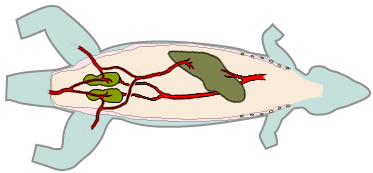Lizard Cardiovascular System
| This article is still under construction. |
Reptiles have a renal portal system where venous return from the tail and hindlimbs may be filtered through the kidneys to bathe the renal tubules. Of surgical importance is the large ventral abdominal vein that lies along the inner surface of the abdominal wall in the midline.
The renal portal system
Venous return from the tail and hindlimbs may be filtered through the kidney or liver. When filtered through the kidney the blood bathes the renal tubules. Theoretically this may affect the pharmokinetics of drugs that are excreted by tubular secretion. In practice this may not be important. It should not affect drugs that are secreted by glomerular filtration.
Heart
Lizards have a three chambered heart with left and right atria and a single ventricle - the interventricular septum is only partially complete but serves to channel deoxygenated blood to the pulmonary trunk and oxygenated blood to the circulation. In addition the atria contract at different times, thus directing the flow of blood between the sponge-like arranged muscle bundles which form the major part of the ventricle.There are paired left and right aortic arches which join caudal to the heart to form a single dorsal aorta.
